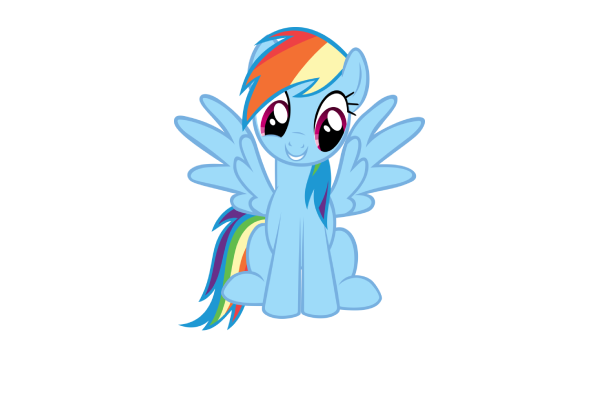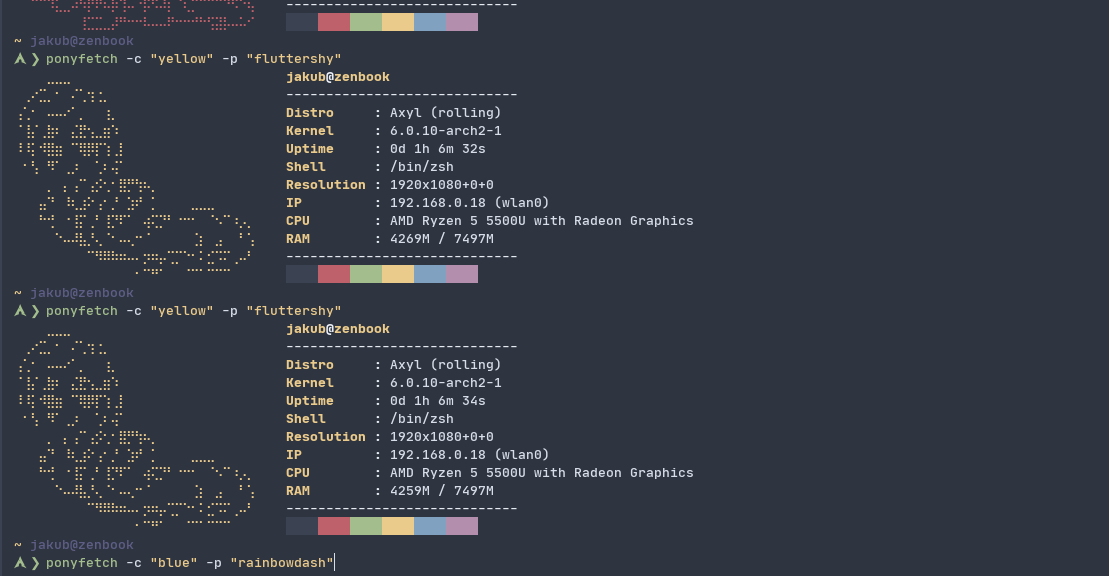| .github/workflows | ||
| ponies | ||
| src | ||
| .gitignore | ||
| Cargo.toml | ||
| install.bat | ||
| install.sh | ||
| LICENSE | ||
| README.md | ||




⚠️ (WIP) This project is not ready for any serious use right now.
A cross-platform command-line interface (CLI) tool written in Rust
to display system information in an aesthetically pleasing and entertaining manner.
📜 Table of contents
- 📜 Table of contents
- ✨ Demo
- 🔧 Using
- 🧪 Requirements for install
- ⚡ Installing
- 🔨 Compiling
- 📚 Contributing
- ⛓️ Sources
✨ Demo
Ponyfetch provides an aesthetically pleasing, colorful display of important system information, complete with charming ponies.

🔧 Using
ponyfetch [OPTION]
| Option | Description | Type | Default | Required? |
|---|---|---|---|---|
-c or --color |
Defines what color to print pony and titles in | String |
blue |
No |
-p or --pony |
Pony to print | String |
rainbowdash |
No |
-h or --help |
Help menu in case you don't understand this one | No |
🧪 Requirements for install
On Linux (MAC not tested), install net-tools package using
sudo apt-get install net-tools
or
sudo pacman -S net-tools
⚡ Installing
If you don't want to compile this tool by yourself, it's possible to just download current build right here.
If you're installing the binary yourself, the install script is useless for you since the directory paths are completely different, so I'll provide the steps here.
- 🐧 On Linux
- First, create ponyfetch directory like this:
mkdir /usr/share/ponyfetch && mkdir /usr/share/ponyfetch/ponies
- Download the ponies from this Github repo amd move them to the ponies directory.
- Move the binary to /usr/bin and /bin
- 🖥️ On Windows
- Create ponyfetch directories like this:
md C:\Program Files\Ponyfetch
md C:\Program Files\Ponyfetch\ponies\
- Download the ponies from this Github repo and move them to the ponies directory.
- Move the executable to "C:\Program Files\Ponyfetch"
- Add the directory mentioned in previous step to the path like this:
setx /M path "%path%;C:\Program Files\Ponyfetch"
🔨 Compiling
Make sure you have rust compiler and build tools installed.
I've made it easy for you, just cd into project folder and run this shell script.
- 🐧 On Linux
chmod +x ./install.sh && sudo ./install.sh
- 🖥️ On Windows
./install.bat
- 🍎 On Mac
(WIP) Ponyfetch was never tested on Mac and it's stability can't be guaranteed.
📚 Contributing
🐎 Adding new ponies
If you wish to add new ponies to the project, please adhere to the following guidelines in order to maintain the project's structural integrity and functionality. The two main distinguishing features of these ponies are their size and style (e.g. Hat or Wings). Refer to the current pony ASCII art to determine the size of your new pony. If your pony is larger than the others, use the format <ponyname>_large. If the size is the same as an existing pony, find a visible difference between your pony and the current one, and name it <ponyname>_<difference>_large. If you are still unsure, please open an issue to discuss it with members of our team. Additionally, after adding a new pony, please ensure to credit the author in the "Sources" section of the README.
🖥️ Modifying & Adding code
Ponyfetch is still under development, so it is likely that there are bugs present. If you encounter one, please open an issue and discuss it with us. Once the discussion is completed, submit a pull request with the proposed changes.
⛓️ Sources
- PYTHON, Clive. In: ASCIIMAN [online]. [cit. 2022-12-02]. Available from: https://asciiman.neocities.org/MLP.html
- My Little Pony ASCII Art. [online]. [cited 2022-12-02]. Available from: https://emojicombos.com/my-little-pony-ascii-art